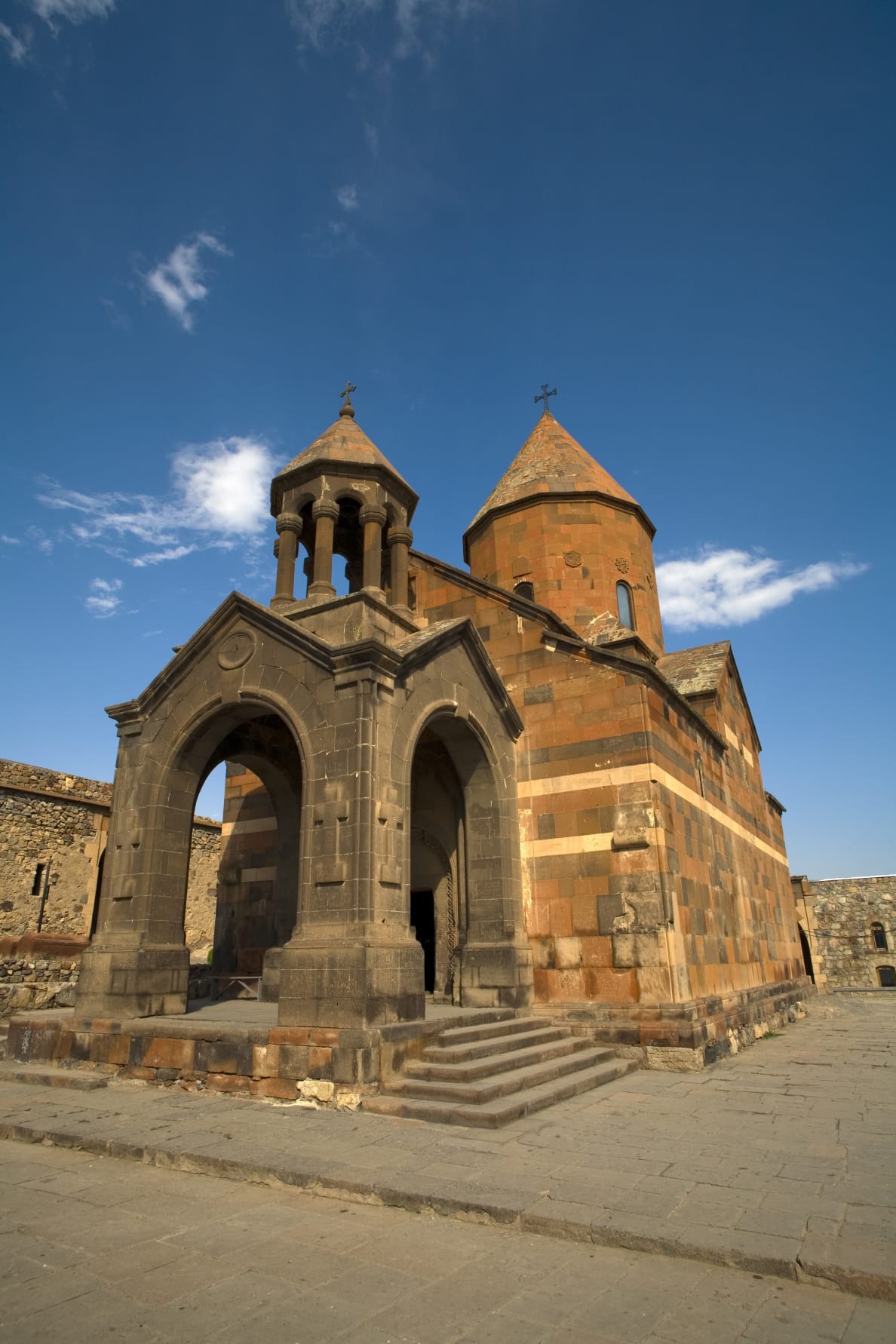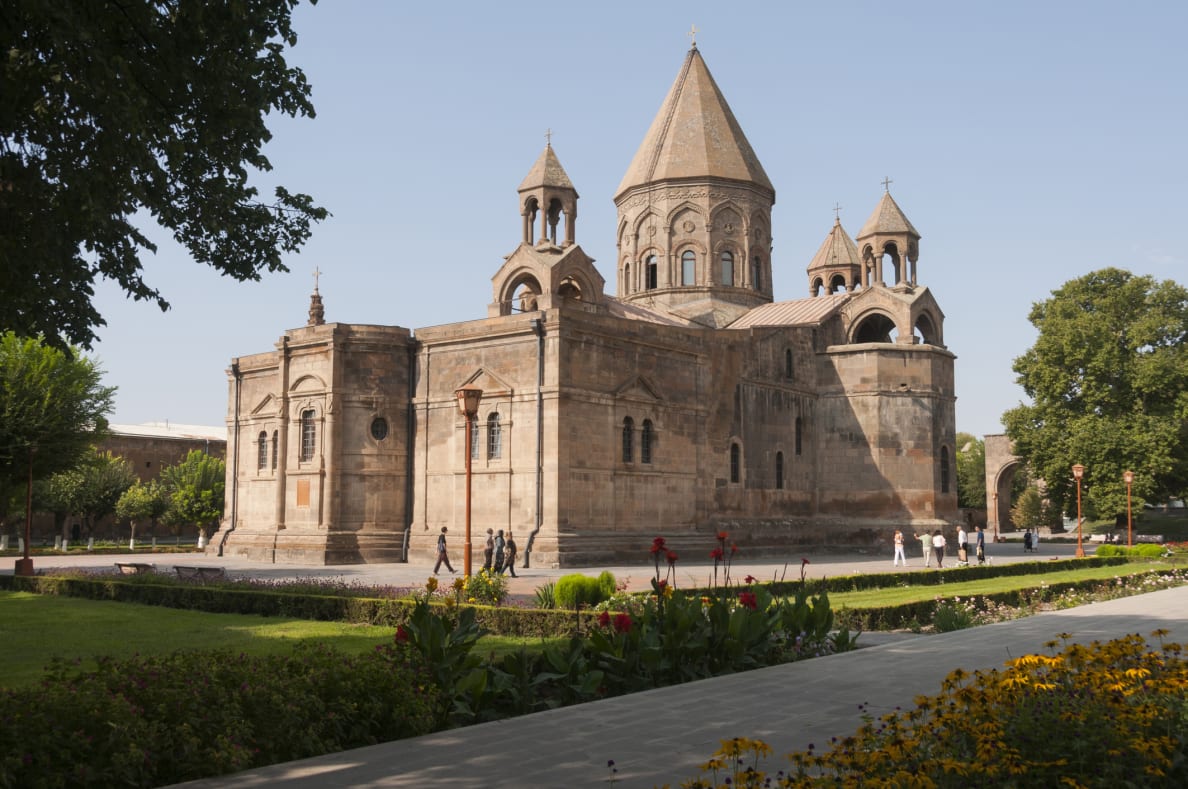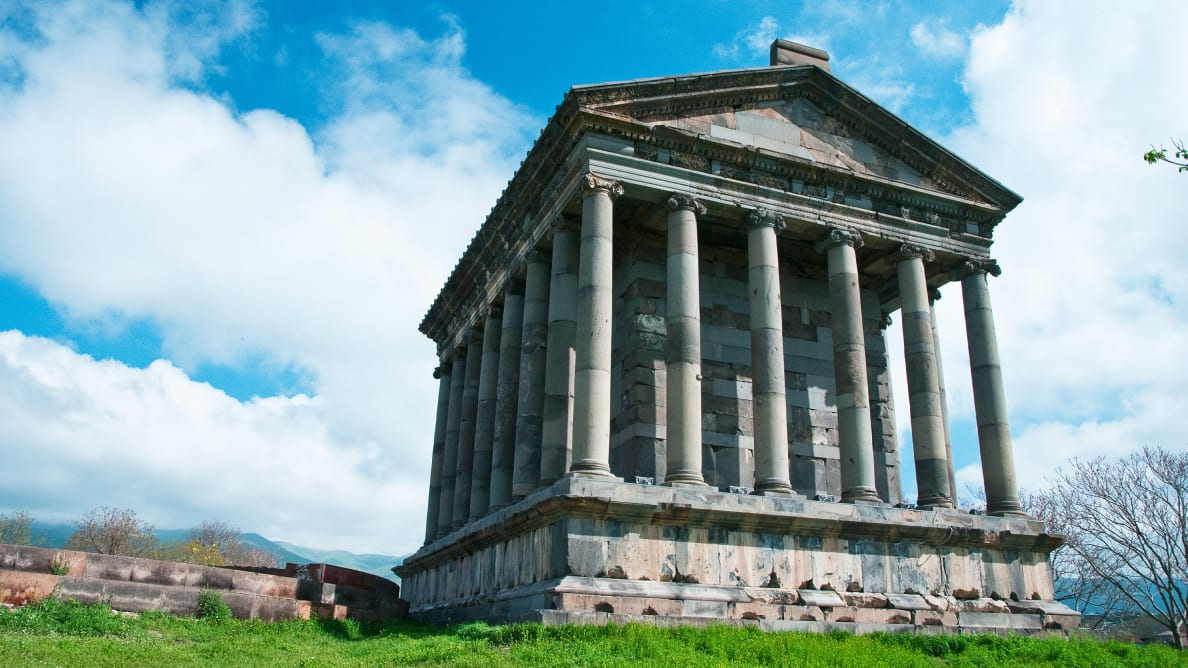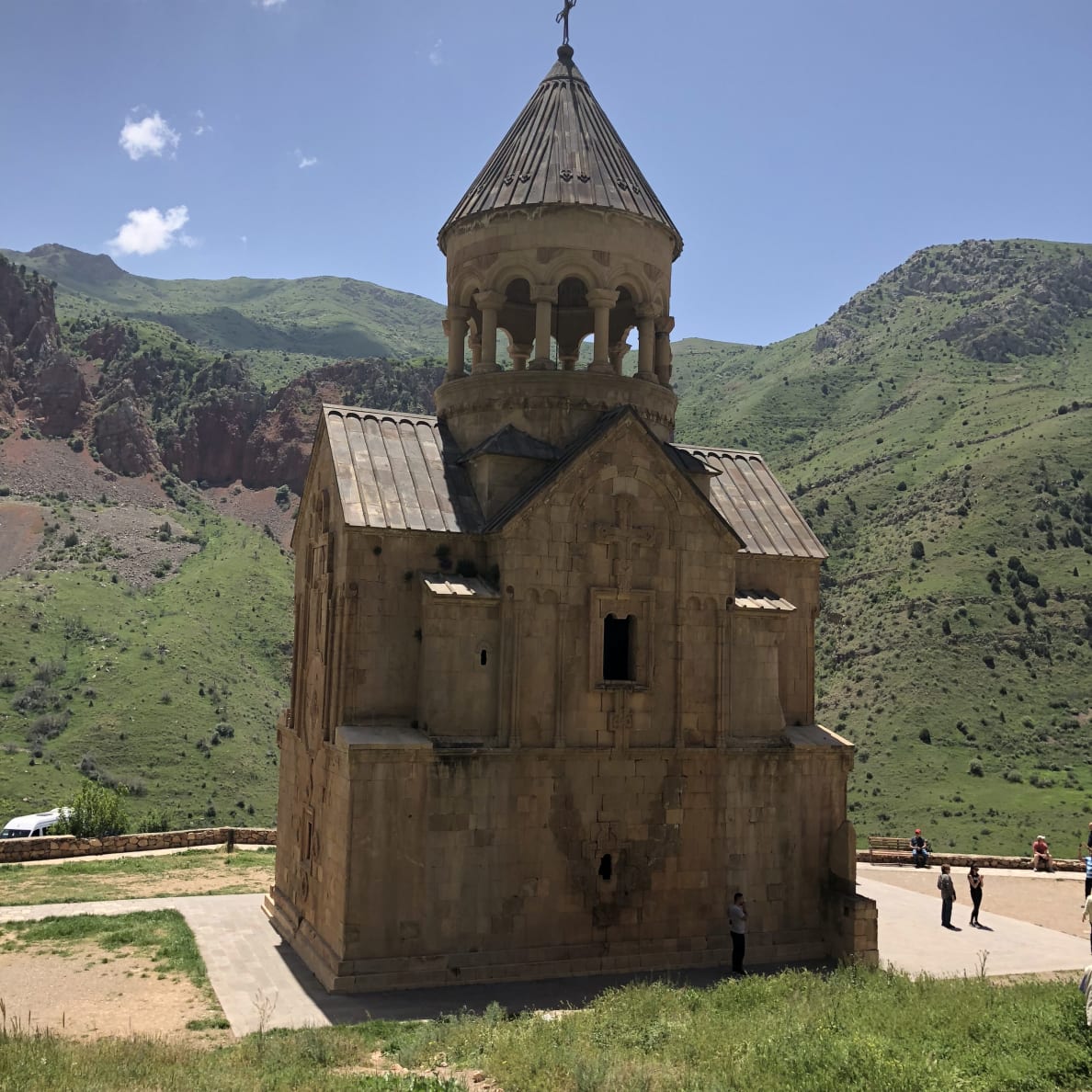y now you’ve no doubt found a coping mechanism for COVID angst—maybe you fold down into child’s pose, zone out with some deep inhales, or simply pour yourself a stiff drink. Me, I like to close my eyes and conjure up one of the most peaceful places I know: Geghard monastery, in the mountains of Armenia. Some days I can almost taste the air inside, cool and pure and sweet with frankincense. Around me, candles flicker in the dimness against rough-hewn walls blackened by smoke and time. Ethereal harmonies spiral up to the soaring cupola, from which a skylight casts a beam of light that warms my forehead if I stand just so. I’m not religious, but in Armenia’s monasteries, I found a glimmer of divine serenity that followed me home.

You’re never far from a church in Armenia, a deeply Christian country bordered by Turkey, Azerbaijan, Georgia, and Iran. Today more than 90 percent of Armenia’s citizens—and millions of diaspora Armenians abroad—belong to the Armenian Apostolic Church, an ancient Oriental Orthodox institution that shares similarities with Coptic, Syrian, Ethiopian, Eritrean, and Indian Churches. In fact, Armenia was the first nation to make Christianity its official region, in 301 AD, some 80 years before the Roman Empire did the same. That head start is one reason the country’s most breathtaking Christian sites are also some of the world’s oldest—take, for example, Echmiadzin Cathedral, said to be the first cathedral on earth, completed (in its first iteration) in 304 AD.
But you don’t have to know this history—much less follow the Gospel—to be blown away by the buildings themselves, and to find rejuvenating quietude within their walls. Crowned by conical domes that pierce through clouds and tower over forests and meadows, Armenian churches are dramatic, and drool-emoji photogenic, especially viewed from afar. Get closer, and you might spot zoomorphic carvings of suns or grapevines or (long-extinct) Persian lions, holdover motifs from Armenian Zoroastrianism. Step inside, and hypnotically interlaced stone crosses, faded frescoes of wide-eyed saints, and secret nooks and passageways will jump-start your imagination and make you want to go exploring like a kid in a haunted house.
A word of advice to first-time visitors to Armenia: Lest monastery fatigue set in, limit yourself to two or three churches a day. Skip the umpteen-stop package itineraries. Roads in Armenia are notoriously curvy, tours long and information-packed, and monasteries filled with curiosities that merit your slow, clear-eyed attention. There may be more churches in Armenia than there are seeds in a pomegranate, but these seven monastic sites—ranging from tiny chapels to grand ecclesiastical complexes—are especially pilgrimage-worthy.

Plastered on t-shirts, printed on postcards, and painted wistfully on walls of Armenian restaurants from Los Angeles to Tbilisi to Paris, Khor Virap is one of the most celebrated symbols of Armenia. When it comes into view, you’ll understand why: The monastery appears to float above a parched plain that stretches to the foot of Mount Ararat, the snow-capped dormant volcano where Noah’s ark supposedly came to rest. It’s all phenomenally scenic, especially on windy winter mornings when the air is at its clearest. Though remnants remain of the original 7th-century chapel, the current structure, with one lone spire, dates to the 1600s. Inside, take the wobbly steel ladder down into the pit where Armenia’s chief evangelizer, Gregory the Illuminator, is said to have been jailed for 12 years by the pagan King Tiridates III.

Etchmiadzin is to Armenian Apostolic Christians what St. Peter’s Basilica is to Catholics and the Western Wall is to Jews: a place of unparalleled religious significance. Called Mayr Tachar (“Mother Church”) by Armenians, it is the seat of the catholicos, the Armenian equivalent of the pope. Its 65-foot-high cupola, ornate bell towers, and central nave blanketed in florid Persianate frescoes make it one of the grandest religious sites in the Caucasus. The site was previously a pagan altar to the fire god Vahagn, so when Gregory the Illuminator built the cathedral, it symbolized the nation’s embrace of Christianity over paganism. Tip: Luckily for travelers crunched for time, Echmiadzin is a 30-minute drive from the capital city of Yerevan, but before striking out, contact Armenia’s Tourist Committee to ensure the interior isn’t closed due to ongoing construction.
Tatev
To Armenian art scholars, Tatev Monastery is synonymous with medieval manuscript production, its prestigious specimens once shipped as far afield as Crimea and Italy. But today the complex is better known for its Wings of Tatev cable car, the “world’s longest reversible aerial tramway,” according to Guinness World Records, which swoops a whopping 5,800 meters up to the 9th-century mountaintop monastery over a clover-green gully.

What is a Parthenon-like Greco-Roman temple doing in the backwoods of Armenia? No one is quite sure, but theories abound: Some scholars believe Garni is a shrine to the Zoroastrian sun god Mihr, while others have posited that it’s the tomb of a Romanized Armenian king or even of the Roman emperor Trajan himself. Though not a church per se, the site holds major spiritual importance for thousands of Armenian Neopagans (newfound adherents to Armenia’s pre-Christian rites) who gather there for ceremonial dances, nature worship rituals, and—until a law forbade it a few years ago—animal sacrifice. Note the smattering of gray slabs interspersed with the lighter stone of the colonnade—these were incorporated in the temple’s reconstruction 1975 for easy differentiation from the original building materials.

Geghard is arguably the crown jewel of medieval Armenian architecture, its chapels hewn into a cliffside set among steep, scrubby peaks. Khachkars, uniquely Armenian “cross stones” bearing mesmerizing carvings of crosses, suns, and other religious and nature motifs, are strewn throughout the complex; you’ll find yourself stopping to simply stare at them as you would a trippy psychedelic animation. As you walk the grounds, ducking into the various churches, chapels, and old priests’ quarters cut into the rock, make a point to seek out Proshyan Dynasty’s zhamatun, or tomb. The doorway to this room is crowned with a primitive pagan relief of two lions with dragon tails flanking a ram’s head. What’s going on is anyone’s guess—so linger for a few minutes and let your imagination run wild. Tip: Combine a visit to Geghard with Garni, a 15-minute drive away.

One of the most splendid church façades in all of the Caucasus can be found at Noravank, a monastery and one-time residence of the Orbelian Dynasty. Momik is the mastermind builder behind the cantilevered stairs (an astonishing architectural feat for the 13th century) that trace up the front entrance; he also carved the lace-like khachkars still standing at the site. See if you can spot the tympanum bearing an uncannily East Asian-looking representation of God; legend has it that invading Mongols spared Noravank because they saw themselves reflected in that image. Indeed, in both architecture and in manuscripts, Armenians would often depict their subjects with the features of the enemy du jour in hopes that their work would not be destroyed.
Sevanavank
Lake Sevan sprawls 1,900 square miles and covers nearly one sixth of Armenia’s surface area. It’s beloved by Armenians for its tranquil beaches and sweet, rosy-fleshed trout, but to visitors, the lake’s main attraction is the 9th-century Sevanavank monastery. It takes a wheezy hundred-step climb to reach the small yet charming church, but the panoramic lake and mountain views from an altitude of 6,200 feet are well worth the sweat stains. Among the twenty-some khachkars spread around the grounds is a unique example bearing a depiction of Jesus on the cross, one of only three such cross stones known to exist.
